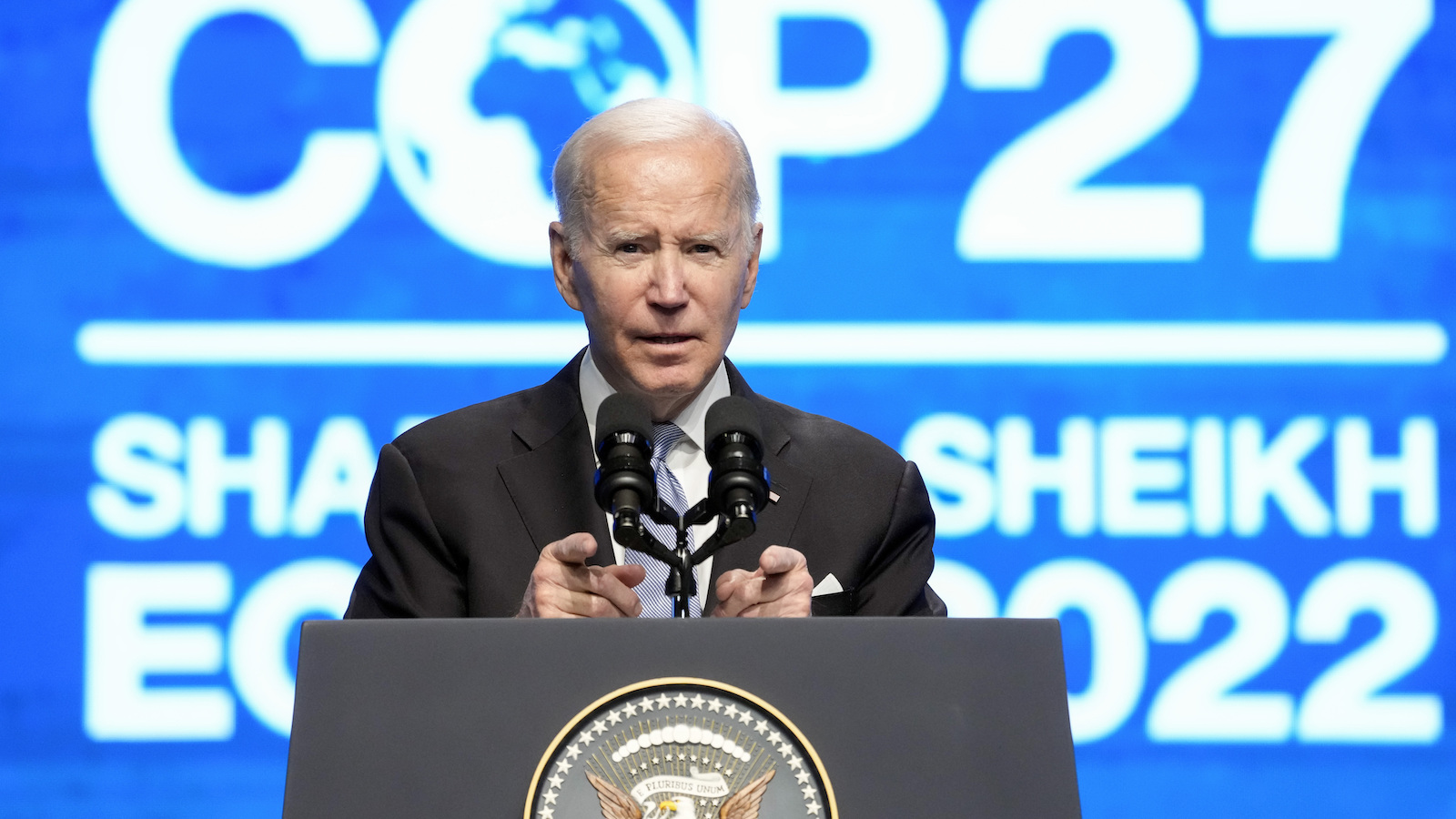President Joe Biden made a brief appearance at COP27, the annual United Nations climate conference, on Friday to try and convince the world that the United States is more committed than ever to tackling climate change. In addition to touting the passage of the biggest climate bill in U.S. history, the president announced several initiatives to cut emissions of the powerful greenhouse gas methane, including new oil and gas regulations at home and a plan to drive down emissions internationally.
Cutting methane emissions is an urgent climate project. The gas is 80 to 90 times stronger than carbon dioxide at heating up the planet in its first 20 years in the atmosphere, and it leaks out of fossil fuel infrastructure ranging from wells to pipelines all the way to power plants and homes. Methane breaks down in the atmosphere in a matter of decades, meaning that addressing these leaks today can reduce its impact quickly — which would slow down climate change and stave off some of its worst effects.
A year ago, the Environmental Protection Agency proposed regulations to address methane leaks from existing oil and gas sites. The U.S. already had some rules in place to prevent leaks from new wells, but existing wells have been allowed to go on polluting. Now, after an extensive public comment period, the agency is proposing even stronger regulations that could take effect as soon as next year. Environmental groups applauded the government on Friday for addressing key concerns raised by experts in their feedback on the original proposal.
“The Biden administration is continuing to advance the ball on these crucial standards,” said Jon Goldstein, the senior director of regulatory and legislative affairs at the Environmental Defense Fund.
Under last year’s proposal, if emissions at a particular oil or gas well were low enough, those wells would be exempt from routine monitoring for leaks. Now the EPA wants regular monitoring of all wells — including those that are no longer being pumped but have yet to be properly shut down. These previously exempt wells, often called “marginal wells” because they don’t produce much oil or gas, are estimated to be responsible for more than 50 percent of all wellsite methane.
The oil and gas industry fought to exclude marginal wells from monitoring, claiming the rules would be too burdensome for smaller companies. But the Environmental Defense Fund found that three-quarters of these wells are in fact owned by large companies that raked in an average gross revenue of $335 million in 2019.
The EPA is also proposing to strengthen limits on “flaring,” an industry practice of burning off methane that comes out of oil wells, converting it into carbon dioxide — which is still harmful to the climate, but less so in the short term. But flares regularly fail, and the less wasteful alternative is to capture that gas and sell it, so that if it’s burned, it’s at least creating usable energy. The new rules would require well operators to capture the gas unless they can prove it’s not feasible or safe to do so.
“While we are disappointed EPA did not propose an outright ban on oil and gas industry flaring,” said Melissa Hornbein, a senior attorney at the Western Environmental Law Center, “we are nonetheless encouraged by the draft rule’s incisive measures to tackle leak detection and repair from all sources, including low-producing and abandoned wells.”
The third big change is a “super emitters program” that would authorize third parties that track methane leaks to notify companies when they detect big plumes and require companies to respond within a matter of days. Satellite companies like Kayrros regularly uncover high-volume methane leaks in the Permian Basin, an oil and gas field that spans West Texas and Southern New Mexico. To date that data has been used to shame companies — now it could be used for enforcement.
The EPA says the rules would deliver an estimated $3 billion worth of climate and health benefits per year, taking into account the costs of compliance. That includes preventing 36 million tons of methane from entering the atmosphere between now and 2030, the greenhouse gas equivalent of shutting down all the coal power plants in the U.S. for a year. The estimate also accounts for eliminating nearly 10 million tons of volatile organic compounds, chemical gases emitted by oil and gas infrastructure that can harm human health and contribute to the formation of ground-level ozone.
Once put into effect, the rules would work in conjunction with a fee on methane emissions that was created by the Inflation Reduction Act, the climate bill Biden signed in August. Beginning in 2025, major offenders will be charged a fee of up to $1,500 for each excess ton of methane they release.
In addition to strengthening regulations at home, Biden is also working to shore up international cooperation on methane. At last year’s climate conference in Glasgow, the U.S. launched the Global Methane Pledge to cut methane emissions from all sources by 30 percent by 2030. At COP27 on Friday, the U.S., along with the European Union and a number of other partner countries, agreed to develop standards for monitoring and reporting methane emissions that would help create a market for “low methane-intensity natural gas.”
More than 130 countries signed on to the Global Methane Pledge, and dozens are expected to release more detailed plans to address methane at the conference. But the initiative has still failed to attract the three of the worst methane offenders in the world — Russia, India, and China.



